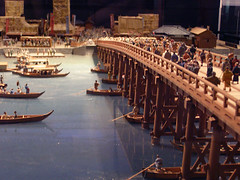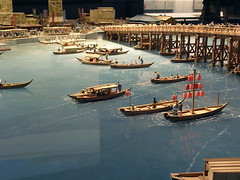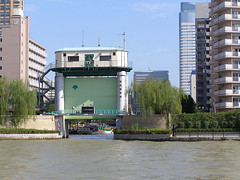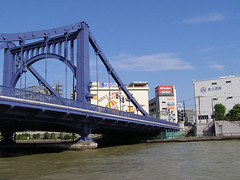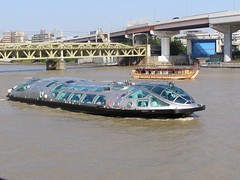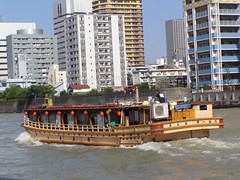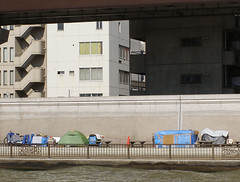Back in the time when Japan closed itself off from interaction with the rest of the world, the city we know as Tokyo was called Edo, meaning "bay door". Before the shogun Ieyasu Tokugawa moved the capital here in 1603, Edo was simply a small fishing village near the mouth of a large river. But the river was a perfect gateway for trade between the fertile flatlands of Kantō and the protected harbor of Edo Bay. With this fortunate geography, the new capital grew quickly to become the largest city on Earth by 1721, with a population of over 1 million.
In those days the city was a dense crowd of wooden shops and houses built on what had once been endless reedy marshes. The upper classes of officials and administrators made homes on the Yamanote hills west of the river, while the lower classes were left the bottomlands which were prone to river floods downstream and typhoon tidal surges upstream. Indeed Edo was often wracked by disaster, and earthquakes and accidental fires destroyed most of the city every generation. The citizens quickly rebuilt after each, with a sort of pride in their ability to thrive under such circumstances.
One of the first infrastructure projects that Tokugawa built in the new capital was a moat around the new Edo Castle. Over the years an extensive system of canals spread through the growing city. As early as the 1600s, the shoguns began a system of levees to protect land from floods and dug channels to force rivers into redirected channels around the city. But commerce must continue, and most goods travelled by river, so in many cases a bit of flooding of poor areas was ignored as long as shipping traffic could continue on free-flowing water highways.
The shogun limited the number of bridges across the big river, as a city defense measure. As bottlenecks of foot traffic, the bridges became public mixing areas and provided pleasant open vistas of the water in contrast to the dense narrow streets of wooden buildings. The approaches at the ends of the bridges became gathering places for watching fireworks during festivals, or simply watching the endless parade of boats below.
The river itself became a ceremonial space, as during certain festivals the boat traffic of fishermen and traders was joined by crowds of tourists making their way up to see the cherry blossoms of Asakusa in a waterborne promenade of social finery. Much lore surrounding the famous bridges over the Sumida and the busy activity of Edo along the river was recorded by well-known artists of this "Floating World" such as Hiroshige and Hokusai.
The city and the river have changed much since then. Concrete apartments are now the typical housing, and foot traffic congregates around train stations instead of bridges. The modernization of Tokyo turned it from a city based around water to one based around railways and roads. Super-levees and floodwalls were been built to channelize andredirect the Sumida and other rivers so many times that they are really more interconnected drainage systems than individual rivers. The Sumida is now just a branch of the Arakawa, with its flow controlled by floodgates upstream that send most of the water into the bed of the larger river which flows east around Tokyo between high levees to the bay.
Through the city, the Sumida is contained by tall concrete floodwalls, giving it a bit of a desolate appearance. The entrances to canals and harbors are guarded by heavy metal gates which can be lowered when a typhoon or flood threatens. Like the Mississippi in New Orleans, in times of flood the water level runs higher than the land around it, but here the levees hold the river back as they are supposed to and life continues on dry land without much thought about the river.
The many bridges across the river are still famous, and its easy to take a boat tour to get a good look at them and learn their stories. Each bridge has its own unique architectural personality, unlike the typical functional engineering of most river bridges in the U.S.
Some of the tour boats themselves are unique as well, such as this futuristic craft designed by a cartoonist to delight children.
Just like in the old days of Edo, it is possible to take a relaxing dinner cruise on the river as well, in floating restaurant boats hung with small lanterns.
But the riverbanks lack the life seen in those old wood prints. The only people who live close to the water nowadays are the homeless, who set up their blue tarp shacks under the shelter of freeway flyovers all along the levee walls. The rent is cheap and the living simpler for these refuges from modern life in the midst of a high-powered metropolis.
At least there is some open space along the water. At some places there are nice parks along the river as well, with walking and bike trails along the levee. But many of the other smaller rivers and canals through Tokyo still have the grim look of oily drainage canals left over from the industrial revolution, unnoticed by most of the pedestrians hurrying back and forth on the bridges above them.

